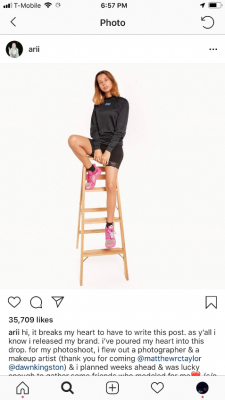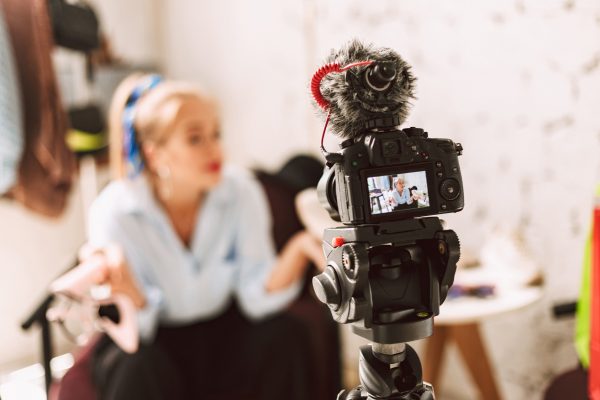You’d figure that with 2 million followers on any platform wanting to engage with you, that even 0.1% of your followers would buy something from you, right? You’d be able to sell 2,000 t-shirts with just a 0.1% of your followers purchasing a t-shirt. How about just 0.01% of your followers? That should give you a sale of 200 t-shirts.
Isn’t that the “role” of influencers? To influence people to do something, to lean a certain way, or even just to purchase a product.
So, it is startling that instagrammer @arii (whose real name is Arianna Renee) with over 2.6 million followers failed to sell a measly 36 t-shirts to her ardent followers.
In her now deleted post, said she was launching a new clothing line, and had to sell just 36 t-shirts for her manufacturing partner to continuing producing the t-shirts for her. So, away she went to launch her t-shirt, and then this happened…

Now, we’re used to seeing Instagrammers promoting different types of products and for a while, you may even believe the products they’re promoting. Because you feel like the influencer is your friend, right?
However, the behind the scenes peek of an influencer with over 2.6 MILLION followers failing to selling 36 t-shirts may come as a shock to some people, but for marketers, we know that an influencer doesn’t necessarily influence people to buy a product. However, different influencers can actually influence people, and here’s how you as a business owner or a marketing manager can make the most out of them.
1. Define your performance metrics and KPIs

If you don’t know where you’re going, any road will get you there. – Lewis Carroll
This simple quote by Lewis Carroll would probably be the most important thing you can do before you run an influencer campaign. Or any campaign for that matter. Ask yourself “What is the goal of my campaign?”
Is it enough if people hear of your brand, or learn of your product?
Are you educating the people on a new product or service?
Do they already know your brand, but maybe you want to change and update their perception of your brand?
Are you looking for sales?
Once you have defined your campaign’s performance metrics and KPIs then can you plan out your campaign. Otherwise, like the Lewis Carroll quote, if you don’t know where you’re going, going by any path will get you there.
So, some examples of the goals of the campaign and how to achieve them:
a) If you’re looking for market awareness, for new people to learn about your product, you’ll need reach. Find the audience you want and get the cheapest type of reach. If there’s two influencers, one with 10,000 followers and another with 1 million followers, go with the one with a million followers (assuming their cost per impression is roughly the same).
b) If you’re looking to educate people on your product, more often than not, you’re looking to educate new customers. Thus, going with influencers you’ve already worked with might not be as good, because their audience would already know your products.
c) If you’re looking to change perception of your brand, this would depend. Is your brand going upmarket? If so, you should work with influencers who are in that target market, and ignore the lower tier / mass market influencers, as who represents your brand will give it the cachet you’re so looking for.
d) If you’re looking for sales, then find the influencers who have high engagement with their fans, instead of those who merely have high followers who may not be as engaged.
2. Find your target audience

Once you’ve set out the goal of your campaign, you’ll need to find out which audience group will give you the best results for your goal.
For example, if you’re running an interior design company, you’ll have to find out what audience will give you the best result based on the KPI you’ve set in step #1. Let’s say you want to go for option (D) Sales.
A guess about your target audience would be probably that they are homeowners, right? Afterall, if you target students, or foreigners / expats, while they might be living in a home in Singapore, they’re probably not going to have the money to spend (students) or they’ll probably be renting (foreigners / expats) and the landlords will not be too pleased to see their house renovated without their permission.
Next thing would be the social economic status of your audience.
Are you a interior design firm that specialise only in private property, with a focus on landed? If so, your audience would probably be the more affluent market, and you’ll want to target influencers who specialise in that market.
No point finding a 21 year old instagrammer who pushes out healthy teas and bikini swimsuits.
3. Find the right influencers

Nearly 78% of marketers say that their top challenge is finding the right influencer according to a study by Linqia. Every minute you spend researching for the right influencer will give you a boost in your campaign’s ROI at the end of the day.
So what should you check for?
Other than getting their deck and rates (usually an influencer would have a prepared deck to show you who their audience is, how much outreach they have, how much do their different services cost, etc), spend time to go through their social media feed.
Here’s a few things to note:
How often do they post?
What do they usually pose?
Do their brand values align with yours?
What are their engagement numbers like? (Likes on a pose doesn’t always co-relate with engagement. Look for numbers of comments, as well as types of comments. You don’t want people to just send <3 “heart emojis” on their posts and nothing else. Also check for the influencer’s replies towards their fans.)
Do their reach and engagement numbers match? (If someone has 1 million followers, and maybe 10,000 likes per post on average, but only 50 comments, of which half are spam, are they really the right match for you?)
One more thing to note is whether they are doing up a post, or a story-style shout out to you (that disappears after 24 hours).
4. Track your campaign
![]()
Go back to #1. What’s your KPI?
If it’s a sale, how do you track it and attribute it to the right campaign, especially if you’re running multiple campaign at once? If you’re unable to track your campaign, then how would you know which is working?
One simple way to be able to attribute the sale to the right campaign is via coupon codes with discounts attached. Say, you’ll give a 10% discount for anyone who uses the coupon code “InfluencerA-10” or “InfluencerB-10”. You’ll have to track it either with your POS or your appointment booking system, but with tracking then will you know which influencer or which campaign gave you the better result.
At the end of the day, if your goal is about reach, then measure it by that yardstick, or if your goal is sales, don’t be fooled by other metrics. Focus on your main KPI, and treat the other metrics as a bonus.
5. Follow up with your influencer(s).

The influencers would have been your frontline soldiers in the battle for attention. Get their feedback because they would have interacted with more of their followers than you.
Things you can review:
Did you campaign resonate with their followers? If so, why? If not, what can be done better?
Was your promotion good? Were their followers clamouring for more freebies?
Was there any hiccups in communication between the influencer and yourself?
This would help you plan your next campaign better, and hopefully, increase your ROI, which ultimately, will grow your business.
Are you looking to grow your business? If so, Warm Media may be right for you. Drop us an email and let us know how we can help you.

